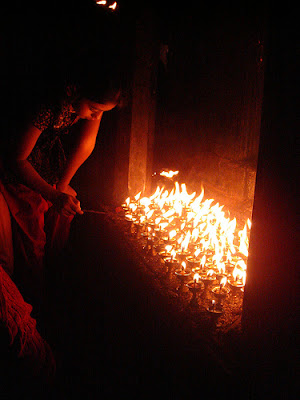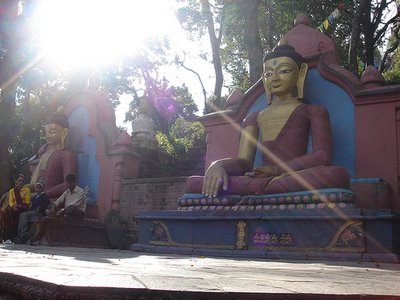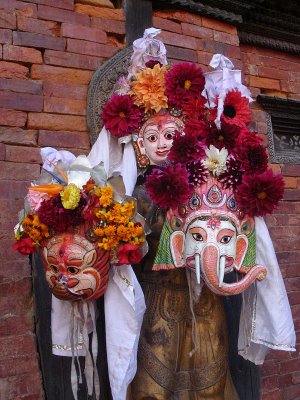A Blessed Diwali to All !
Sweets on the street
Leh, Ladakh
There aren't many Hindus here in Ladakh. Just a
 few shopkeepers (sweet shop and general store owners mostly), and men in the Army. The only Hindu temples are rather garish, brand-spanking-new concrete ones created to serve the Army men. They are painted bright comic-book colours and look jarring against the sombre grey landscape with its white-washed Buddhist chortens and occasional onion-domed mosques.
few shopkeepers (sweet shop and general store owners mostly), and men in the Army. The only Hindu temples are rather garish, brand-spanking-new concrete ones created to serve the Army men. They are painted bright comic-book colours and look jarring against the sombre grey landscape with its white-washed Buddhist chortens and occasional onion-domed mosques. Where there are Hindus, though, there is colour, festivity and lots of sugar, and Leh is no exception. Today is Diwali, a festival of light, the most universally-observed Hindu holiday that is also honoured by Sikhs, Jains and anyone with a general sense of fun. (It's actually a series of days...but that kind of gets lost up here).
Yesterday many shops were closed, but sweets vendors had opened special stalls making fresh jalebis in the open-air cold, and displaying all manner of fancy boxed milky Indian confections. Stationers sell tinsely garlands and ropes of plastic flowers (since real ones aren't available here in the cold season). And print icons of the goddess Lakshmi, usually accompanied by Ganesh and Saraswati, beam benevolently from every corner.
(The photos on this page are taken from various past celebrations in Nepal and Kerala.)
Timing is everything
It wasn't easy to find a solid meal in town yesterday. I had a steaming bowl of vegetable thukpa (Tibetan noodle soup, 30Rs) with lots of cilantro in the tiny, gloomy Tibet Restaurant as dusk gathered. Across the room huddled a group of four British girl
 s, who had clearly just arrived in Leh. They were warming their hands round cups of tea, nibbling naan and poring over their Lonely Planet guides. (The Lonely Planet section on Ladakh is terrible. Most everything in it is wrong. More about that later.)
s, who had clearly just arrived in Leh. They were warming their hands round cups of tea, nibbling naan and poring over their Lonely Planet guides. (The Lonely Planet section on Ladakh is terrible. Most everything in it is wrong. More about that later.)I almost felt sorry for them. Why had they arrived so late in the season? Just a few weeks ago, the gold and copper leaves were sparkling like amber in the fall afternoons. Now the rows of flaming poplars are grey skeletons, though skies are still blue.
"Hi!" piped up one of them. "Would you like to join us?"
I pulled up a chair. "Have you just arrived?" I asked, out of politeness but completely unnecessarily.
Turns out they have been in India for six weeks, and already "done" Kerala, Mumbai and Rajasthan.
"We really wanted to see the Himalayas," said one, "even though obviously the timing isn't right...." Another one sneezed and asked the Tibetan Amala for a napkin.
As I heard their itinerary, I realised they had done everything backwards. Had they only reversed their schedule and done Ladakh six weeks ago, *then* headed southward for Rajasthan (which is just now in its best season) and eventually to Kerala in late November, they would have missed the Kerala monsoon rains (which they caught instead) and seen Ladakh in its full fall blaze and the end of harvest celebrations.
Just a little bit of research makes all the difference in your trip. India (and Nepal) covers a vast area, none of it uniform in weather or landscape. Going to a particular place at the right or wrong time can very simply determine whether it's miserable or magical. Earlier this September, I met a Dutch couple who had somehow been convinced to travel to Rajasthan for a camel safari...in mid-August.

Needless to say, the desert was scorching hot at that time. Some travel company had talked them into it.
And last August, a dear friend (who shall remain nameless) and I met up in Kathmandu. He eagerly asked where he could see "the mountains." Which mountains? He looked impatient. "The Himalayas, of course." I had to break the news to him.
He had managed to arrive at the absolute worst season for viewing. Unless you take a plane - and maybe even if you do - you will see no snowcapped Himalayas until second week of October. Most of the country is blanketed in monsoon clouds during summer. Then he admitted, "I didn't do any research before my trip."
I met a new friend at the Indian Embassy in Kathmandu this past summer. She desperately wanted to get out of Kathmandu and do some trekking. She too had arrived at the worst time - not only are the views concealed by clouds, but the trails are full of leeches during the wet season. She was actually in Nepal at the ideal time to be in Ladakh - summer. If she had reversed her trip and gone to India first, then Nepal, she could have landed up in the Mountain Kingdom's spectacular viewing weather (October-December).
Timing is everything. After seeing so man ill-timed disappointed travellers, I can recommend consulting the guidebook under the "When To Go" heading, check the weather on an internet site like Weather Underground (link at sidebar on left), and prioritize accordingly!





















